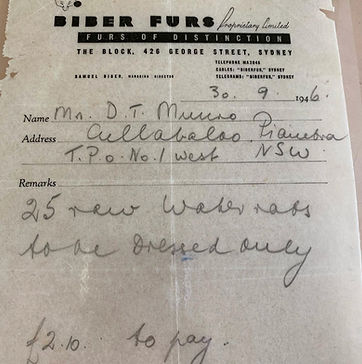
1946 Australian Water Rat Evening Stole.
This very unusual fur stole was donated to the museum recently. The stole belonged to Mrs Monroe who lived on a property in the central west of NSW which had a 3 mile frontage to the Castlereagh River. Water rats were prolific in the river and her husband called them Australian mink. He caught the rats often in traps made from old jam tins and then sent the 25 pelts he caught to Biber Furs in Sydney to have them made into this evening stole that his wife loved to wear to balls.
The Australian water rat is also known by the indigenous name of rakali. Not to be confused with the commonly seen introduced rats, the Australian water rat is a native species with a lifestyle similar to that of an otter.
Today, these animals are completely protected and although rarely seen, are considered to be in good numbers. Growing up to 35cms in length, rakali typically live in burrows near water, feeding on fish, insects, yabbies and water birds. Throughout the early twentieth century, they were widely considered to be a nuisance and were hunted for their soft and waterproof fur. Demand for rakali pelts increased during the 1930’s Depression years, when a ban was placed on the import of overseas furs; rakali fur became a popular substitute for the fur of the American muskrat. The species were placed under a protection order in 1938, although periodic culls were allowed until 1957 due to their perceived destruction of irrigation banks and fishing nets.
These pelts were collected in the 1940’s, when attitudes to fur and killing wildlife were very different. In fact, women were encouraged to wear fur as wool was needed for the war effort.




_edited.jpg)
_edited.jpg)